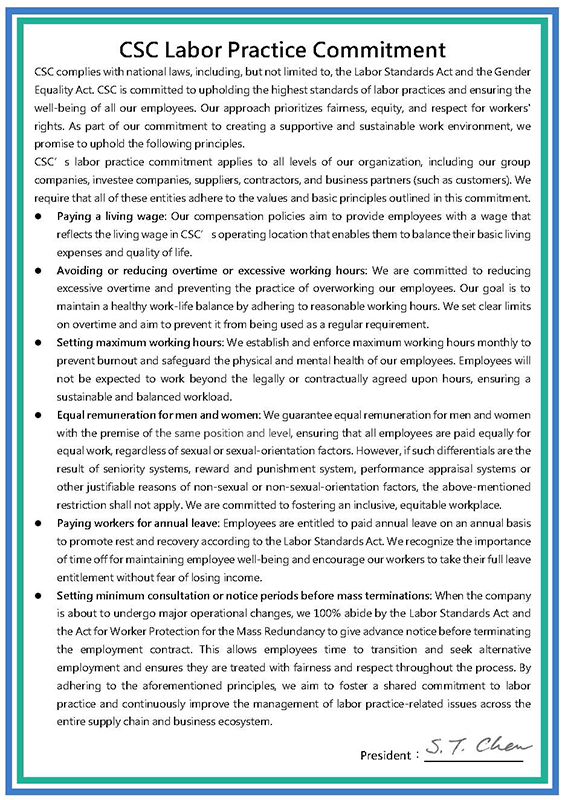Talent Attraction & Retention
Labor Practice Programs
-
Ensure adequate wages at or above cost of living estimates or benchmarks
CSC conducts regular market salary surveys to continuously optimize the compensation standards for new hires. We aim for entry-level wages that are not only compliant with national minimum wage requirements but also exceed local living wage benchmarks.
To support this, the company references the Living Wage Global Dataset and local cost-of-living data of its operating sites to align its compensation practices with living wage standards. This commitment is upheld through three key measures:
- Monitoring changes in living wage benchmarks and local cost-of-living data.
- Adjusting entry-level salary standards when needed.
- Implementing annual salary adjustments based on market salary trends and the company's business performance—with an average annual increase of 3.17% over the past 12 years.
These efforts collectively aim to enable all employees receive a living wage.
-
Monitor working hours including overtime management
CSC imposes a monthly overtime cap of 46 hours in line with labor regulations. For employees whose overtime exceeds 32 hours in a month, approval for additional overtime must be referred to general manager. This policy guarantees adherence to legal standards and facilitates the prompt identification of unusual or unexpected overtime patterns.
-
Ensure employees are paid for overtime work
CSC conducts monthly audits to verify all overtime hours are correctly recorded and compensated according to labor laws and company policies.
-
Regularly engage with workers' representatives on working conditions
To promote sound labor relations, CSC holds labor-management meetings monthly—exceeding the minimum quarterly requirement. Additionally, each plant or department organizes communication meetings with employees every two to three months to gather feedback and collaboratively address issues. Collective agreements with the Labor Union, covering 100% of full-time employees, are reviewed every three years to uphold fair and reasonable labor conditions.
-
Routinely monitor the gender pay gap to achieve equal remuneration for men and women
CSC's compensation policy emphasizes that there are no differences based on gender. To reinforce this commitment, CSC discloses gender-based pay differences across job levels on an annual basis and provides explanations for any gaps observed, such as variations in seniority between genders. In addition, CSC conducts annual industry salary benchmarking using variables such as job category, gender, or seniority to support its remuneration policies remain competitive in the market. CSC remains firmly committed to internal pay equity by consistently applying fair and non-discriminatory principles across all compensation decisions.
-
Expand social protection coverage for workers beyond public programs
CSC offers various types of leave that are superior to regulatory standards and provides an Employee Stock Ownership Trust (ESOT) to safeguard employees' retirement life.
-
Ensure employees are taking their paid annual leave entitlements
CSC grants paid annual leaves. Employees who have worked continuously for CSC for a specified period are entitled to paid annual leaves on an annual basis in accordance with the Labor Standards Act, and any unused paid leaves at the end of the year or upon contract termination are compensated in wages.
-
Provide training or reskilling to mitigate negative effects of industrial or climate transition changes
As climate transition policies evolve, the company anticipates shifts in required employee skillsets. In line with our commitment to continuous human capital development, we support employees in acquiring necessary skills and assist in matching them with suitable roles. This contributes to sustained value creation while promoting shared growth for employees, the company, and society.
Parental Leave
CSC's policies regarding parental leave comply with government regulations. The rate of employees returning to work after parental leave was 100% in 2022, which showed the workplace friendliness and the adaptability of employees when they returned to duty.
| Years | 2022 | 2023 | 2024 | |||
|---|---|---|---|---|---|---|
| ItemsNote | Males | Females | Males | Females | Males | Females |
| The numbers of employees entitled to parental leave | 827 | 43 | 465 | 34 | 1,144 | 24 |
| The numbers of employees who took parental leave | 8 | 9 | 14 | 8 | 26 | 16 |
| The numbers of employees who were reinstated after having taken parental leave (a) | 4 | 5 | 8 | 11 | 19 | 11 |
| The numbers of employees who should be reinstated after having taken parental leave (b) | 4 | 5 | 10 | 11 | 20 | 11 |
| The reinstatement rates (a ÷ b x 100%) | 100% | 100% | 80% | 100% | 95% | 100% |
| The numbers of reinstated people who took parental leave in the previous year (c) | 4 | 14 | 8 | 11 | 8 | 11 |
| The number of people who had worked for one year after having applied for reinstatement in the previous year (d) | 4 | 14 | 8 | 11 | 8 | 11 |
| The retention rates (d ÷ c x 100%) | 100% | 100% | 100% | 100% | 100% | 100% |

